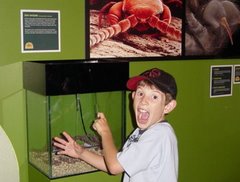
Today we were fortunate to have Kevin von Appen, Ontario Science Centre, and Caroline Payson, Cooper-Hewitt National Design Museum, talk to a group of staff about what they do. These are my very rough notes.
Some points from Kevin’s talk:
• Social nature of Australians makes us prime candidates to uptake social media
• 1 in 6 teens in Australia has their own blog (I suggest this figure is higher give that MySpace and Bebo have their own blog function)online experiences are rooted in the physical (i.e. the stuff we have – I found this strongly when talking to students at e-kids’ college)
• Museums – we’re all in this together
• Web allows museums to react quickly to big issues (and invite others to collaborate I would suggest)
• One way to get content out there is to colonise virtual communities (e.g. YouTube and Facebook)
• Video is an increasingly popular tool (more downloads of videos from their site than everything else put together)
• Operated in a skunkworks kind of approach – created sites outside of the corporate site in order to experiment – challenge now is to bring these all together
• Rapid idea generator (RIG): process to generate lot of ideas around a specific topic, challenge or opportunity and to physically manifest ideas in unexpected ways to create unexpected dialogue
Websites presented:
• SFMOMA podcasting and Vox Pops
• steve.museum
• Ilikemuseums
• Science buzz (Science Museum of Minnesota)
• Redshift Now
Caroline’s points:
• Had to think about conjunction between physical presence and web presence – how to make the best of both?? Used a problem-solving approach to come up with ideas and approaches
• They do have access to great people
• Can’t be all things to all people all the time – this is unachievable
• They decide to focus on one group and branch out from there
• 9 online visitors to 1 physical visitor – mostly clicking on the educational aspect
• Teach teachers how to think like designers to take back into classroom to go through processes of design – design as a process is a great way to work together and create knowledge and is relevant across other disciplines apart from just design
• Site focusses on process not objects – they consciously made this decision
• Design for the other 99% exhibition had a bigger life after the physical exhibition closed
• Emphasised the casual nature of the blog – it’s not an academic treatise
• Their Director made them work differently – you won’t have three specialist meetings each week, you’ll have two and spend the other time on your blog
• There’s’ a community out there no matter what you’re interested in (even knitters who watch Law and Order and have cats ... umm, I tried to find this blog but got led on an merry adventure by Google, can’t say any more than that!)
• Caroline’s “butt rule”: should be able to get everything you need (i.e. resources) without moving your butt
• The Educator Resource Centre site is well worth a good look and play
• Conversation strand – has become the place for design teachers across US to talk about design education, also searchable and can upload fotos and video
• Did a lot of user-testing with teachers
• Have paid teachers to post, write materials and moderate (in future)
• Online visitation has increased 9-1, more visitors than the museum shop
Web philosophy – embrace collection and get more online, everything online supports the mission, reach other audiences, one site will meet the needs of all areas of the museum.
Overall an exhausting, yet highly productive and stimulating day. Kinda looking forward to another full day tomorrow!



No comments:
Post a Comment